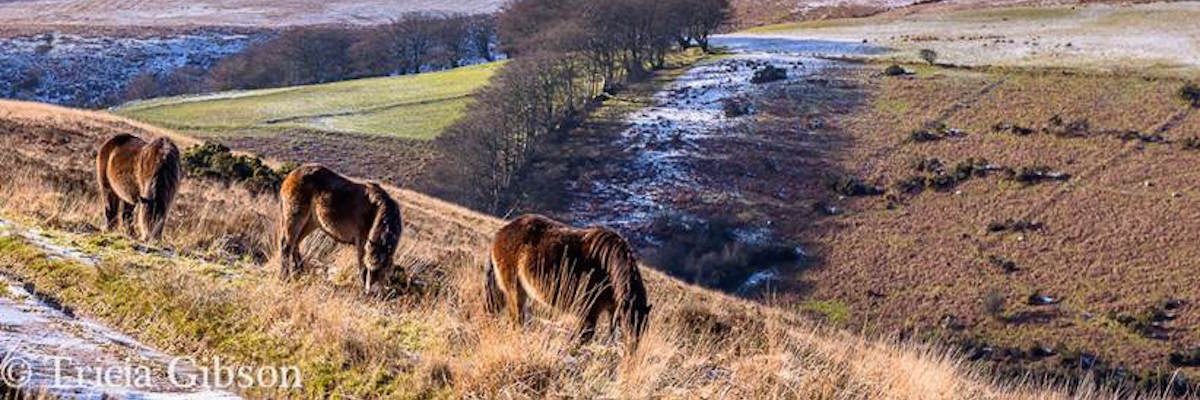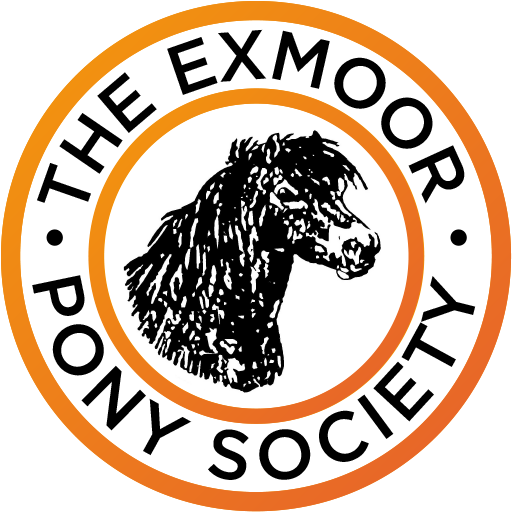
The Conservation of the Exmoor Pony
The Exmoor Pony Society was formed in 1921 with the specific aim of ensuring that this rare native breed continued to run free on Exmoor and to exhibit all the traits and characteristics of its ancestors. More can be read about the history of the Exmoor Pony (which is currently on the Rare Breed Survival Trust’s Watchlist in Category 2, endangered) in the book ‘Survival of the Fittest’ by Dr Sue Baker.
All the Exmoor ponies on the moor are owned by moorland farmers who have specific grazing rights. The moor is divided up into commons and while some commons are home to only one herd, in some instances up to three herds can be seen running on one common.
It is for this reason that the visual identification of the ponies is so important and recognised by many welfare organisations as paramount to the long term welfare of the free-living ponies.
The farmers and local Society members monitor the herds at key stages of the breeding cycle, making notes of which mares are in foal and when the foals are born. This greatly assists the Society in ensuring that the parentage of the ponies is correctly recorded at the time of inspection.
Why is the conservation of Exmoor ponies important?
At the end of the Second World War, there were only about 50 ponies left on the moor. These ponies formed the basis of the 20 or so herds which can now be seen running on Exmoor and under the Exmoor National Park Authority’s Management Plan, it is hoped that the number of herds will increase allowing members of the public to view these magnificent ponies in their native environment.
The genetic pool is, therefore, very small and it is necessary to try and preserve as many of the original blood lines as possible to ensure the long term welfare of the ponies on the moor.
An increasing number of ponies are being bred away from the moor and some of the bloodlines that had become absent on Exmoor are being reintroduced thanks to the efforts of a group of dedicated breeders who are working closely with the Exmoor Pony Society.
The Society provides information on blood lines to its members and both moorland and in-ground breeders are working to preserve the genetic pool.
Exmoor ponies are also bred in a number of European countries both in free-living and in-ground situations which the Society hopes will ensure the preservation of the breed should any particular country be subject to an outbreak of an infectious equine disease. In 2014 a small breeding group was exported to the Czech Republic as part of programme to reintroduce wild horses.
As well as providing the ability to monitor the herds, the visual identification of Exmoor ponies ensures that any animal injured can be reported to the owner and also ensures that ponies dumped on the moor are reported quickly and can be taken off the moor as soon as possible.
Every Autumn, the ponies are “gathered”. The herds are brought in off the moor to their home farms. This allows herd owners to decide which foals are to be retained and which are to go on to new homes and also to monitor the condition of the ponies and remove any which are not deemed in sufficient condition to survive the harsh Exmoor winter.
In order to ensure that the characteristics and traits of the Exmoor pony are maintained, every foal born to registered parents is inspected by the Society’s inspectors. These inspectors, who are all long-time Society members with an in-depth knowledge of the breed, undergo an assessment and three year training programme to ensure that the handling and inspection of the foals is carried out as efficiently and sympathetically as possible.
Whilst the Exmoor Pony Society has a derogation from DEFRA that allows for moorland foals to leave the moor on a passport application form without being micro-chipped, it was the Society’s considered opinion in June 2009 that all foals should be micro-chipped so that important bloodlines were not lost.
In addition to the inspection of foals, the Society ensures that all colts used for breeding pass a veterinary inspection and a Society inspection to ensure only those stallions that fully meet the breed standard and display good movement and conformation are used for breeding purposes.
Each year, the vast majority of colt foals are taken off the moor and sold as potential riding ponies or go to conservation grazing sites around Britain.
The work of the Exmoor Pony Society means that we have one of the most well respected breeding programmes of all the native breeds thus ensuring the long term survival of the breed. It also enables the Society to provide information to such Government bodies as the National Farm Animal Genetic Resources Committee (FAnGR) which advises the UK and devolved governments on matters to do with farm animal genetics.
The Exmoor Pony Society has always recognised the importance of keeping records of the Exmoor ponies bred throughout the world. Without such information it would be not be possible to monitor the small gene pool available to ensure the conservation and preservation of the breed. Through the work of members who have an interest in genetics including Debbie Davy (2001) and Michael Dewhurst (2014) – both recipients of the Marsh Award for Conservation in Genetic Bio-Diversity run by the Marsh Christian Trust and the Rare Breed Survival Trust – the bloodlines are carefully monitored by the EPS and for the last 20 years have also been monitored by eminent geneticists from RBST. The Exmoor pony is recognised as a rare native breed by both the Rare Breed Survival Trust and the Farm Animal Genetic Resource Committee.
Registration into the Exmoor Pony Society stud book
The Exmoor Pony Society is a registered charity whose main objectives are to promote Registered Exmoor ponies and to encourage and maintain the standard of ponies used for breeding.
A registered Exmoor pony is a pony whose sire and dam are registered in the studbook and is in line with the EU/DEFRA legislation of 2006 which stated that all ponies whose parents are registered in the studbook must be included in the main section of that studbook.
The main section of the Exmoor Pony Society studbook is divided into two and records the pedigree of foals born each year. The studbook dates back to 1921 and was closed in 1962.
To be eligible for the main section of the studbook all ponies must have parentage recorded in the studbook and be a by a registered/approved sire.
Section 1 (buff coloured passport) – ponies who meet the breed standard
Section X (blue coloured passport) – ponies who have not met the breed standard, have not been put forward for inspection or are awaiting re-inspection. A pony that subsequently meets the breed standard upon re-inspection can be upgraded into Section 1.
This means all ponies currently registered in the Exmoor Pony Society studbook can trace their parentage back over many generations.
No pony of known parentage is excluded from the main section of the studbook.
For the purposes of maintaining the Charity’s objectives, to promote registered Exmoor ponies, most EPS area shows hold classes for both Section 1 and Section X ponies and to encourage and maintain the standard of ponies used for breeding, the Society recommends that ponies entered into Section X are not bred from and for this reason only Section 1 ponies are eligible to compete at the Breed Show.
The future
The Exmoor Pony Society works closely with all its breeders both within the Exmoor National Park, the home of the breed, and throughout the UK and abroad.
When Mary Etherington first took ponies to Edinburgh at the end of the Second World War and began breeding at the Royal Dick Veterinary School, it was the start of the Society’s pioneering work in conservation. Whilst British native breeds were being lost, the Exmoor pony was going from strength to strength. Although the Exmoor pony will continue to be listed as Endangered by the Rare Breed Survival Trust because of its small genetic pool, the breed has flourished.
In 1948 two ponies were sent to London Zoo to highlight the fact that only 50 ponies remained on the moor. There are now approximately 500 ponies on Exmoor and a further 3,500 in locations across the UK and several other countries. Although numbers are healthy, the vast majority of ponies are in non-breeding situations. That said, the genetic pool is well represented on Exmoor and in other geographical areas worldwide thus ensuring that even if disaster, such as disease, struck on Exmoor the breed would not be lost. The herds could be re-instated and the Little Horses of Exmoor would be able to be enjoyed by future generations.
Today, new challenges face the breed. As the equine and welfare organisations call for responsible breeding, Exmoor pony enthusiasts must walk a tightrope between breeding enough ponies to conserve the bloodlines but equally not over-breeding so that every registered Exmoor pony foal has a future. The future for many is as family, competition and driving ponies as well as working hard to conserve the British countryside.
Conserving Exmoor ponies has a direct effect on the conservation of Exmoor itself as over the centuries the ponies have been instrumental in creating the unique habitat that is Exmoor as we know it today.
